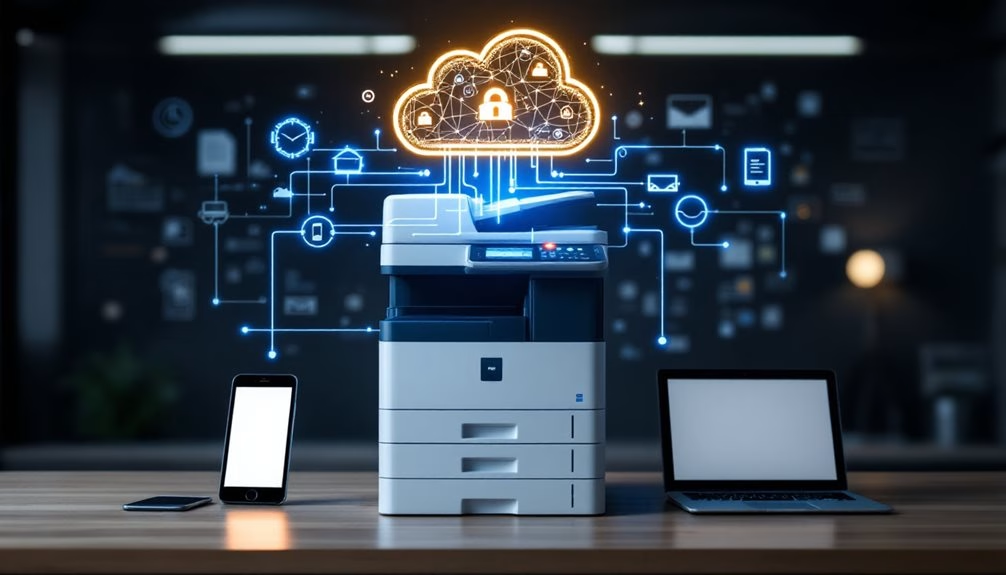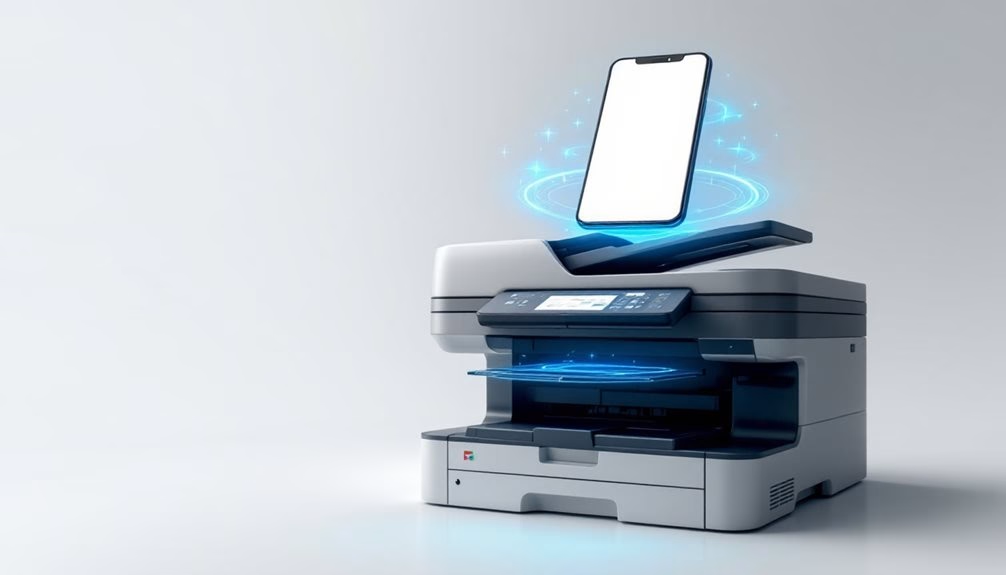In today’s fast-paced office environment, we can’t afford to overlook the features that make modern copiers essential business tools. We’ll explore what separates basic machines from true productivity powerhouses – from cloud connectivity to advanced security protocols. Whether you’re upgrading outdated equipment or selecting your first multifunction device, the right features will dramatically impact your workflow efficiency and bottom line. The difference between choosing well and choosing poorly? Thousands in potential savings or costly regrets.
Expert Highlights
- Check for cloud connectivity options that integrate with services like Google Drive, Dropbox, or Microsoft OneDrive for anywhere access.
- Look for robust security features including user authentication, hard drive encryption, and secure transmission protocols.
- Ensure energy efficiency with ENERGY STAR certification, sleep modes, and duplex printing capabilities.
- Verify mobile compatibility including AirPrint support, email-to-print features, and smartphone app integration.
- Consider document management capabilities like OCR text recognition, automated filing, and remote print queue management.
Cloud Connectivity and Digital Document Management

While traditional copiers focused solely on physical document reproduction, today’s modern devices offer seamless cloud connectivity and extensive digital document management.
We’ve seen how these features transform our workflows. By connecting to services like Google Drive, Dropbox, and Microsoft OneDrive, we can scan documents directly to the cloud and access them anywhere. This means we’re no longer tethered to physical locations.
Many of us appreciate how these systems integrate with our document management software, allowing for automatic filing, OCR text recognition, and version control.
We’re able to search, share, and collaborate on documents more efficiently than ever before. Leading suppliers now offer expert maintenance services that ensure these advanced digital features continue to operate at optimal performance levels.
Security Features to Protect Sensitive Information

Modern copiers safeguard your sensitive documents through multiple security measures: user authentication methods that verify identity before granting access to device functions, hard drive encryption that protects stored data from unauthorized retrieval, and network security protocols that secure information during transmission.
We’ll examine how these features work together to create a thorough security framework for your organization’s document handling.
Let’s explore these critical protections that have become essential in today’s privacy-conscious business environment.
Implementing advanced protection protocols through Managed Print Services further strengthens the security architecture of your entire print environment, preventing unauthorized access to confidential information.
User Authentication Methods
As organizations increasingly prioritize information security, user authentication methods have become essential features of modern copiers. We now see options ranging from simple PIN codes to advanced biometric solutions like fingerprint scanners and facial recognition.
Card authentication systems let us tap employee badges for quick access, while department codes track usage across teams. Many copiers integrate with existing network directories (like Active Directory), allowing us to maintain consistent login credentials across all office systems.
These authentication methods don’t just protect sensitive documents—they help us create accountability, control costs, and guarantee everyone in our workplace community accesses only what they need.
Hard Drive Encryption
Security concerns extend beyond user authentication into the very heart of copying devices themselves. Modern copiers store sensitive documents on internal hard drives, making encryption essential for protecting our data from unauthorized access.
| Encryption Type | Protection Level | Best For |
|---|---|---|
| AES-256 | Military-grade | Healthcare |
| FIPS 140-2 | Government-certified | Financial |
| Self-encrypting | Hardware-level | Legal firms |
We recommend choosing copiers with automatic encryption that secures data at rest and in transit. Look for models with secure erase features that completely remove sensitive information after printing. This guarantees our documents remain protected throughout the copying lifecycle.
Network Security Protocols
Network connectivity in today’s copiers requires robust security protocols to shield information from interception or unauthorized access.
We recommend selecting devices that support TLS/SSL encryption for all network traffic, ensuring data remains secure during transmission.
Look for copiers offering 802.1x authentication, which verifies devices before they connect to your network.
IPsec compatibility is also essential, as it creates encrypted tunnels for your data.
Many of our clients appreciate models with SNMPv3 monitoring capabilities and configurable firewall settings.
These features let us maintain visibility while preventing unauthorized access—keeping our shared information protected in today’s increasingly connected workplace.
Mobile Integration and Remote Printing Capabilities

Three major advancements have revolutionized how we interact with modern copiers: mobile integration, cloud connectivity, and remote printing capabilities. We’re now untethered from physical proximity, with options that let our team print from anywhere. Whether for commercial business settings or home-based environments, these features provide flexibility across all usage scenarios.
| Feature | Benefit |
|---|---|
| Mobile Apps | Print directly from smartphones/tablets |
| AirPrint/Cloud Print | No drivers needed for quick printing |
| Email-to-Print | Send attachments directly to copier |
| QR Code Access | Secure, contactless document retrieval |
| Print Queue Management | Control jobs remotely, saving time |
These innovations guarantee we’re always connected to our printing resources, enhancing collaboration while maintaining security.
Speed, Volume, and Paper Handling Capacities

Modern business environments demand copiers that can handle substantial workloads without sacrificing efficiency.
We’ve found that investing in machines with appropriate speed ratings and paper capacity saves countless hours of productivity.
When evaluating your next copier, consider these critical specifications:
- Pages per minute (PPM) – matches your team’s daily output needs
- Paper capacity – reduces frequent reloading interruptions
- Multiple paper size handling – accommodates everything from postcards to banners
- Output tray capacity – prevents overflow during large jobs
We’ll help you select equipment that grows with your organization, ensuring you’re never left waiting when deadlines loom.
Our factory-trained technicians provide comprehensive support with a 4-hour response time to maximize your equipment’s performance and uptime.
Energy Efficiency and Environmental Impact

While evaluating a copier’s performance capabilities is important, today’s businesses must also consider the environmental footprint of their office equipment.
We’re seeing more models with ENERGY STAR certification, which can reduce power consumption by up to 50% compared to standard machines.
Look for features like automatic sleep mode and programmable power schedules that minimize energy use during off-hours.
Many manufacturers now use recycled materials and offer eco-friendly toner options.
We recommend choosing machines with duplex printing to cut paper waste in half.
Additionally, some vendors provide recycling programs for used cartridges and end-of-life equipment, helping us all contribute to a more sustainable workplace.
Leasing eco-friendly copiers offers financial flexibility while demonstrating your commitment to environmental sustainability through access to the latest energy-efficient technology.
Cost Analysis: Lease vs. Purchase Options
When deciding how to acquire a new copier, businesses face the critical choice between leasing and purchasing.
We’ve found that leasing often works best for teams wanting lower upfront costs and regular technology updates. Purchasing makes sense when we’re looking for long-term savings and asset ownership.
- Leasing typically includes maintenance and supplies in monthly payments
- Purchasing provides tax advantages through depreciation
- Leasing offers predictable budgeting without surprise repair costs
- Buying eliminates contract renewals and potential fee increases
Let’s consider our usage volume, cash flow situation, and how long we’ll need the equipment before deciding which option aligns with our company’s financial strategy.
Frequently Asked Questions
How Long Do Modern Copier Components Typically Last Before Needing Replacement?
We’ve found that modern copier components typically last 3-5 years, though high-volume parts like drums and fusers need replacement sooner. Let’s plan for regular maintenance to keep our machines running smoothly.
What Noise Levels Should Be Expected From Different Copier Models?
We’ve found most modern copiers operate at 50-70 dB. Entry-level models are typically noisier at 65-70 dB, while premium office copiers run quieter at around 50-55 dB for our comfort.
Can Copiers Be Integrated With Existing Document Management Software?
Yes, we can integrate most modern copiers with your existing document management software. Many offer API connections, direct scanning to cloud platforms, and customizable workflows that’ll enhance your team’s productivity.
How Much Physical Space Is Required for Different Copier Sizes?
We’ve found copier sizes vary widely – desktop models need just 2-3 square feet, mid-range units require 10-15 square feet, while enterprise systems may need 20+ square feet including workspace clearance.
What Type of Training Is Needed for Staff to Use Advanced Features?
We’ll need basic training sessions for our staff to master advanced copier features. Most vendors offer free onboarding, and we can supplement with short how-to guides for day-to-day operations.
Expert Final Thoughts
We’ve covered the essentials of modern copiers, from cloud connectivity to cost analysis options. As we evaluate these machines for our workplaces, let’s remember that today’s best copiers aren’t just about making copies—they’re extensive document management systems that enhance security, support remote work, and reduce environmental impact. By prioritizing these features, we’ll guarantee our investment serves our evolving business needs for years to come.
About the Expert
Rafael M.
CEO of JR Copier
With over 35 years of hands-on experience in the copier and office printer industry, Rafael brings unparalleled expertise to every client interaction. His journey from service technician to CEO provides him with comprehensive understanding of all aspects of the business.
Areas of Expertise: Copier and printer sales, equipment leasing strategies, maintenance solutions, and managed print services. Rafael's deep industry knowledge ensures clients receive expert guidance, transparent pricing, and exceptional service for all their office equipment needs.
Connect on LinkedIn